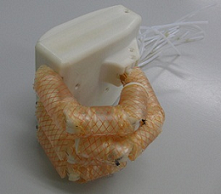http://bsclarified.wordpress.com/2011/11/09/grasping-a-new-reality/
Mindful of the ageing population in Japan, engineers are motivated to develop robots that could one day assist the elderly in their daily tasks. Developing a robotic hand that shows dexterity and variable pressure capabilities is the first step in creating robots that will be able to perform everyday tasks.
In the October issue of Smart Materials and Synthesis (doi:10.1088/0964-1726/20/10/105015), Dr. Nagase of Kwansei Gakuin University in Sanda, Japan and his colleagues describe their design for a new robotic hand that mimics the dexterity and grasping abilities of a human hand. Not only does the hand perform similarly to a human hand, its size and weight are almost identical to the average adult hand.
 Robotic hand developed by Dr. Nagase at Kwansei Gakuin University and his colleagues
Robotic hand developed by Dr. Nagase at Kwansei Gakuin University and his colleagues
Perhaps future robots will be modelled after humans so that it will be more comfortable when the robots assist the elderly. Wouldn’t you think it is intimidating to have a large robotic hand turn the page for you as you read?
The robotic hand has four fingers attached to a palm, and each finger consists of three joints that allow the fingers to bend and flex. The palm and the ‘bones’ that make up the fingers are made of ABS resin. Silicone rubber tubes with Kevlar fibres inside as reinforcement encase the ‘bones’ and form individual fingers.
http://ist.ksc.kwansei.ac.jp/~nagase/index_e.html
A balloon actuator causes the hand to open and close. The balloon actuator consists of a silicone tube that is sealed at one end and expands to produce a balloon when compressed air is supplied through the opened end. A metal ‘tendon’ is wrapped around the balloon and expands when the balloon expands. This forms a pulley system and acts as the joints in each finger.
The balloon actuators allow individual fingers to be controlled, so the hand can hold objects in different ways:
- Fully grasp an object with the fingers and thumb
- Pinch an object using the thumb and index finger
- Support an object using the fingers as a platform and the thumb to hold an object
***Watch the robotic hand in action on Dr. Nagase’s website: Robot handic holding a paper cup

No comments:
Post a Comment